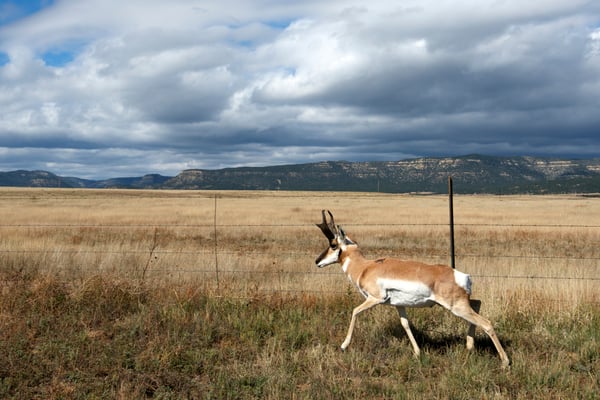I was today years old when I learned that Pronghorns, an animal you may have never heard of, used to dominate the American landscape. When we think of North America pre-European settlement, images of the iconic American bison roaming the plains certainly come to mind. The pronghorn? Not so much. I can honestly say I hadn't even heard of the Pronghorn until I moved to Colorado. I was astounded when I learned that prior to westward expansion, there were around 40 million pronghorns across North America with some estimates saying their populations surpassed even that of the bison. The more I learned, the more I became enamored with these beautiful creatures - the fastest animal in North America.
Pronghorns have roamed this landscape for a very long time, being one of the few surviving animals from the last Ice Age. The oldest fossil record of a pronghorn relative dates back 28 million years. Many different kinds of pronghorns had evolved and died out until Antilocapra americana, our modern day pronghorns were the only ones left. Why these pronghorns were the only ones to survive remains a mystery, but it’s safe to say that these animals have proved themselves survivors many times over.

The fastest land animal in the Western Hemisphere may have roamed North America for millions of years
Thousands of years ago, North America was a very different place with very formidable predators like saber-toothed cats, short-faced bears and American cheetahs. This forced pronghorns to evolve certain traits in order to survive. Around 10-12 thousand years ago, these predators would be extinct along with 80% of North America’s megafauna. It was surely the pronghorn's incredible adaptations that helped them to endure this extinction event.
Known as ‘prairie ghosts’, they are particularly adapted to live in grasslands and sagebrush habitats. As the fastest land animal in North America, with speeds up to 60 mph, they had evolved to outrun anything on the plains. They have what is known as binocular vision, with massive eyes that allow them to detect movement up to 4 miles away with time to spare. They are equipped to outlast and outrun but they aren’t invincible.
By the early 20th century, 99% of their population had been wiped out by market hunting and increased human expansion. Growing human populations decreased pronghorn habitat and barred pronghorns from their traditional migration routes. Pronghorns are known to travel the same routes their ancestors once took and are notoriously poor jumpers. With increasing ranchland and the resultant fences, pronghorns were unable to move freely like they once could; limiting their access to important food sources and making them more susceptible to predation. However, beginning around the 1920’s, focused conservation efforts allowed pronghorn populations to stabilize once again.

Pronghorns are unable to move freely like they once could.
Having lived on this land for so long, pronghorns have formed an intimate connection with the ecosystem that surrounds them. Pronghorns have evolved to rely on Sagebrush, a shrub emblematic of the Western US. Unfortunately, increasing development, aggressive invasive species and climate change have caused Sagebrush to become one the most threatened ecosystems in the United States. Sagebrush ecosystems don't only support Pronghorns but form the largest natural system in North America, serving as a vital home for thousands of species.. In the world we live in now, their speed will not be enough to keep them or their habitat alive - they can't outrun degradation and human development.
I want you to picture the American west. Picture rolling hills of the blue-green sagebrush sea and hundreds of pronghorns galloping in the distance. Hold on to that image. With greater awareness and restoration efforts, we might be able to ensure that this image can survive a few more thousand years.
Bella Whiting is a naturalist at Walking Mountains who has developed a borderline unhealthy obsession with Pronghorns.







